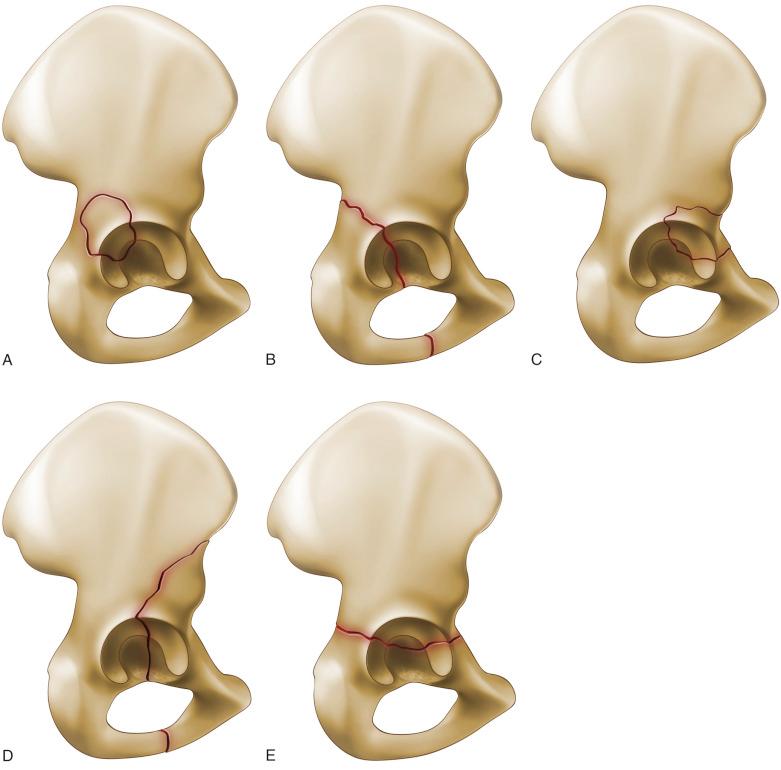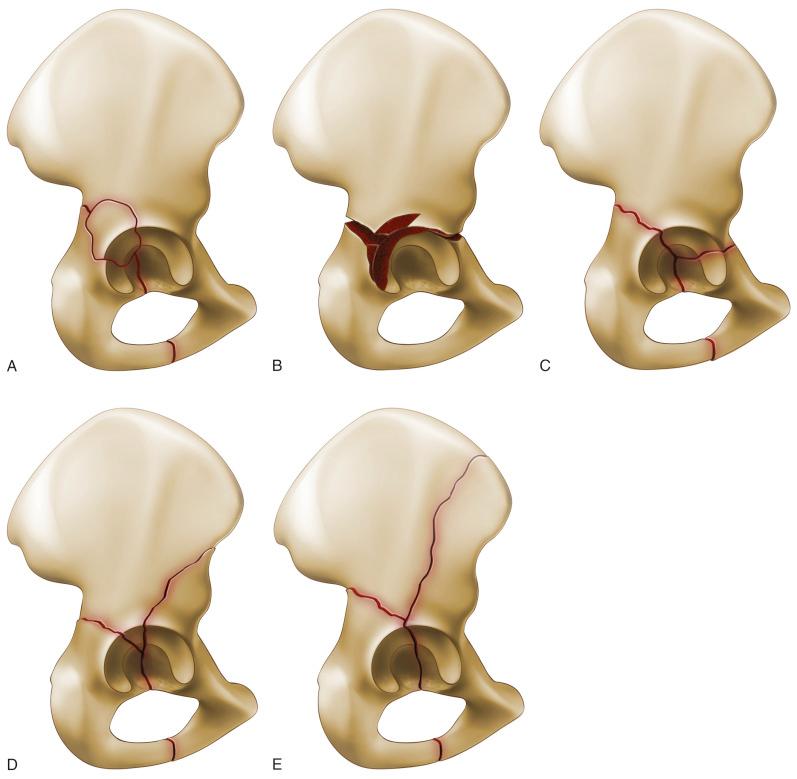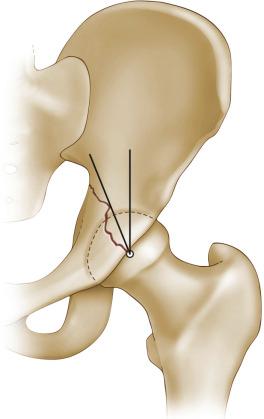Physical Address
304 North Cardinal St.
Dorchester Center, MA 02124
In evaluating acetabular fractures, accurate imaging of the pelvis is needed with plain radiographs, oblique radiographs, and, frequently, three-dimensional imaging.
Treatment is guided by classification of the fracture pattern and assessment of the fracture location and displacement, along with patient-specific considerations, such as age and bone quality.
Operative approach for open reduction and internal fixation is based on fracture pattern; classification and choice of the optimal approach correlates with successful fracture reduction and fixation.
For selected fracture patterns in elderly patients, there is a role for primary total hip arthroplasty.
The acetabulum is a socket-like structure contained within the innominate bone ( Fig. 46.1 ). It consists of two basic components: the anterior and posterior columns. It is a complex three-dimensional structure, which, in contrast to long bones, is more difficult to visualize and understand from standard planar radiographs. Fractures of the acetabulum provide unique challenges in diagnosis and treatment. Although many surgeons may be comfortable with even difficult fractures on the femoral side of the hip, the same cannot be said for the pelvic side. Reasons for this include the difficulty of (1) understanding the complex three-dimensional geometry of the innominate bone of which the acetabulum is a part; (2) safely accessing the fracture fragments, which may lie deep within the pelvic anatomy; and then (3) accurately reducing and fixing the fractures themselves. Surgical treatment of these injuries depends on knowledge and skill regarding the intrapelvic structures, which often are not part of the acumen of the orthopedic surgeon. Although complications and surgical misadventures in long-bone surgery may contribute to morbidity confined to the musculoskeletal system and the particular extremity involved, complications in this type of surgery may also involve multiple unfamiliar organ systems to which the orthopedist often is not exposed.
In contrast to other “articular” reductions, surgical treatment of acetabular fracture is frequently an indirect reduction of the joint, because the actual articular surface is rarely directly visualized. Essentially, bony landmarks are reduced and reconstructed, and the articular reduction is assessed radiographically.
Entire volumes and fellowships have been dedicated to this complex subject; thus, the purpose of this chapter is to provide an overview and review for the reader who may encounter these injuries.
The basic problems are as follows:
Assessment of fracture pattern, bone quality, presence of arthrosis, and functional status.
Decision for surgery: Will outcome be improved by surgical intervention? Is surgery indicated, feasible, or advisable?
Complex surgical approaches.
Difficulty reducing and fixing fracture fragments.
The incidence of acetabular fracture is believed to be approximately 3 in 100,000 patients; primary causes include motor vehicle accidents and falls from a height. Although many are high-energy injuries, low-energy fractures may occur in situations of bony insufficiency. The primary mechanism is a blow to the femur at the level of the knee or trochanter. Some fracture patterns are more common than others (e.g., the posterior wall in the younger population and anterior column posterior hemitransverse in the elderly). Owing to the numerous positions of the femur related to the pelvis at the time of injury, as well as the infinite directions and amounts of force, fracture pattern variability is high. Acetabular fractures frequently may be associated with other life-threatening injuries.
The classification of Letournel and Judet, which has been shown to have high interobserver and intraobserver reliability, remains the standard. Classification consists of the following five elementary patterns ( Fig. 46.2 ):
Anterior wall fracture
Anterior column fracture
Posterior wall fracture
Posterior column fracture
Transverse fracture

Five associated fracture patterns are as follows ( Fig. 46.3 ):
Anterior column plus posterior hemitransverse
Posterior column plus posterior wall
Transverse plus posterior wall
T-shaped fractures
Both-column fractures

Infinite variations in fracture geometry may exist in nature. The purpose of this classification was not just merely to categorize fracture patterns but to provide guidance for which surgical approach would best fit the particular fracture pattern, as no single approach is ideal for all of these injuries.
The main considerations for deciding on nonoperative versus operative treatment are the following:
Displacement
Location
Stability
Patient-related factors
The goal of surgical intervention is to restore the articular surface anatomically so that hip joint function may be preserved and ensuing arthrosis may be prevented. Incongruity is poorly tolerated in this load-bearing joint and likely will lead to poor outcomes.
Less than 3 mm of articular incongruity is probably the threshold that would be accepted for nonoperative treatment. However, other factors—such as patient age, comorbidities, and the location of the displacement—matter as well. An intact roof arc or weight-bearing dome has been shown to be the most critical area to assess and relates most closely to the prognosis for the secondary development of arthrosis ( Fig. 46.4 ). Roof arc measurements are defined as a line subtended from a vertical line to the center of rotation of the acetabulum to where the fracture crosses the radiographic dome of the acetabulum medially. Displaced transverse and anterior and posterior column fractures that have a medial roof arc angle less than 45 degrees (measured on an anteroposterior [AP] pelvis radiograph), anterior roof arc angle less than 25 degrees (measured on the obturator oblique radiograph), and posterior roof arc measurements less than 70 degrees (measured on the iliac oblique radiograph) cross the weight-bearing portion of the dome and necessitate fixation. However, roof arc measurements may not be helpful in both-column fractures, where relative congruence of the acetabular fragments to the head may exist, even though the hip is not in its proper location in space relative to the axial skeleton. Furthermore, roof arc measurements are not useful for all fracture patterns : for example, they are not helpful for determining the need for surgical intervention for posterior wall fractures. Close clinical and radiographic follow-up is necessary in nonoperative treatment to evaluate the patient for any secondary displacement during early healing. Stress views may be helpful in predicting secondary displacement for fractures in which the stability of the hip is uncertain from radiographs alone. These are performed with the patient supine flexing the hip to 90 degrees and applying longitudinal force along the axis of the femur posteriorly while assessing for subluxation or medial clear space widening on AP and obturator oblique fluoroscopic images, if stable, then assessed with 20 degrees adduction and 20 degrees internal rotation.

Become a Clinical Tree membership for Full access and enjoy Unlimited articles
If you are a member. Log in here